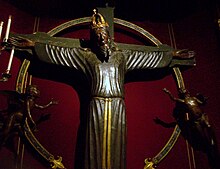
Back Santa Faç de Lucca Catalan Volto Santo von Lucca German Santa Faz de Lucca Spanish Crucifix de Lucques French Volto Santo di Lucca Italian Volto Santo (Święte Oblicze) Polish Volto Santo Russian Sveto lice Lucce Serbo-Croatian Volto Santo, Lucca Slovenian



The Holy Face of Lucca (Italian: Volto Santo di Lucca) is an eight-foot-tall (2.4 m), ancient wooden carving of Jesus crucified in the cathedral of San Martino, Lucca, Italy. Medieval legends state that it was sculpted by Nicodemus who assisted St. Joseph of Arimathea in placing Christ in his tomb after the crucifixion. The same legends placed its miraculous arrival in Lucca to AD 782.
Radiocarbon dating of both wood and canvas places it between 770–880 AD, which corresponds to the Legend of Leobino according to which the Holy Face arrived in Lucca from Palestine in 782 (another copy says 742).[1][2][3]
The Holy Face is located in the free-standing octagonal Carrara marble chapel (the tempietto or "little temple"), which was built in 1484 by Matteo Civitali, the sculptor-architect of Lucca, to contain it. The tempietto stands in the left-hand aisle of the cathedral of San Martino in Lucca.
Copies of a similar size from the 12th century are found widely spread across Europe. These include the Cross of Imervard in the Brunswick Cathedral at Braunschweig, Germany, the Holy Face of Sansepolcro at Sansepolcro, Italy and possibly the Batlló Crucifix of Barcelona, Spain.[4] The Holy Face is also depicted on a 14th-century gothic fresco in a Lutheran church in Štítnik, Slovakia.[5]
"By the Holy Face of Lucca" was a phrase often used by William Rufus when swearing to perform an act or deed during his reign as King of England.
- ^ Povoledo, Elisabetta (19 June 2020). "A Long Revered Relic is Found to be Europe's Oldest Surviving Wooden Statue". The New York Times.
- ^ "Arte. Il Volto Santo di Lucca è la più antica statua lignea d'Occidente. Ecco le prove". www.avvenire.it (in Italian). 2020-06-20. Retrieved 2020-06-22.
- ^ Guidi, Pietro (1932). "La Data Nella Leggenda Di Leobino". Archivio Storico Italiano. 90 (Serie 7, Vol. 18) (4 (344)): 153–164. ISSN 0391-7770. JSTOR 26241065.
- ^ Gertrud Schiller, Iconography of Christian Art. Volume 2. The Passion of Jesus Christ. Janet Seligman (tr.), Greenwich, CT: New York Graphic Society, 1972: 144-5, 472-3.
- ^ "Štítnik, ev. a. v. kostol". Gotická cesta (in Slovak). 23 August 2018. Retrieved 27 Nov 2020.